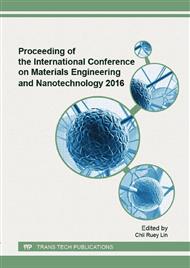p.11
p.15
p.19
p.23
p.27
p.32
p.38
p.42
p.46
Effect of Glycidyl Methacrylate (GMA) Content on Grafting Yield and Mechanical Properties of GMA Grafted Poly(Lactic Acid) Prepared by Melt Mixing Method
Abstract:
Glycidyl methacrylate (GMA) was grafted onto poly (lactic acid) (PLA) by internal mixer using dicumyl peroxide (DCP) as an initiator. The results from proton nuclear magnetic resonance (1H-NMR) and gel permeation chromatograph (GPC) indicated that the grafting reaction of GMA onto PLA took place successfully. In order to obtain the optimal GMA content used to graft onto PLA chain, the GMA content was varied into 5, 10 and 15 wt% of PLA. GMA content of 10 wt% was found to give the highest elongation at break of glycidyl methacrylate grafted poly (lactic acid) (PLA-g-GMA). The weight-average molecular weights, the number-average molecular weights and polydispersity index of PLA increased after grafting with GMA. After grafting, the brittle fracture behaviour of PLA was changed to ductile fracture behaviour of PLA-g-GMA. With its superior mechanical properties compared to those of pure PLA, PLA-g-GMA can be considered to be used as a new generation of biodegradable polymer, which can be applied in many industrial applications.
Info:
Periodical:
Pages:
27-31
Citation:
Online since:
September 2016
Price:
Сopyright:
© 2016 Trans Tech Publications Ltd. All Rights Reserved
Share:
Citation:


